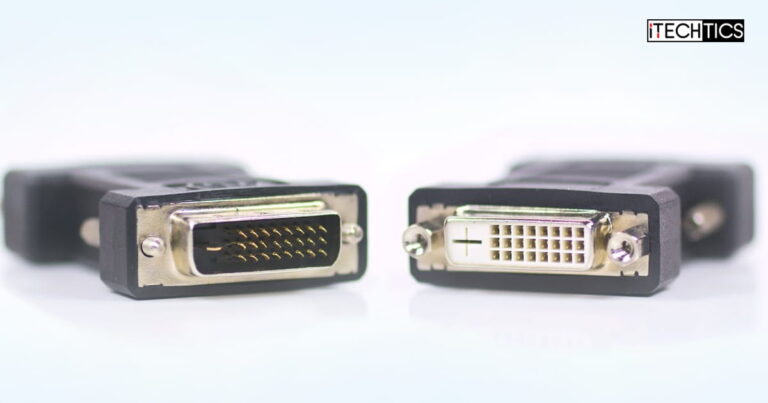As technology continues to advance at an unprecedented pace, so too does the demand for high-quality visual display interfaces. One of the most popular digital interfaces used today is the Digital Visual Interface, or DVI interface, which transmits digital video signals between computers and display devices.
But did you know that there are several types of DVI connectors, each with its own unique capabilities and limitations?
In this article, we will explore the DVI type differences, delve into the details of each type, and examine how they can impact your viewing experience.
Table of Contents
On This Page
What is DVI?
The Digital Display Working Group (DDWG) created the Digital Visual Interface (DVI), a port used to efficiently connect digital-to-digital display devices, like LCD monitors or projectors. DVI eliminates outdated analog video systems and sends uncompressed data for interactive visuals on certain displays. With its revolutionary technology, DVI is ushering in an era of faster response times and higher-quality images.
DVI cables offer high resolution and image quality. They also offer more convenience as these cables can be easily hotplugged anywhere.
DVI Purpose and Working Mechanism
DVI was designed to transmit digital data from computers to display devices, such as LCD monitors or projectors. As the transmitted information is always binary, each pixel of the source device will be precisely reflected on the receiving end.
This contrasts with analog systems that suffer electric attenuation and noise interference while transferring images. This is where DVI comes into play and prevents such interference with ease. On top of its impeccable accuracy, this technology also offers a significant reduction in power consumption.
DVI cables were initially designed as an improvement on VGA cables but later were superseded by HDMI and display cables.
DVI is compatible with modern multimedia interfaces known as HDMI. Although audio data cannot be sent directly through a DVI connection, some video cards can accommodate sound and visual signals, allowing them to send both from a computer to an HD display or TV via HDMI.
If your hardware doesn’t permit this transfer of information then you’ll need an adapter that can merge the visuals processed by DVI with either digital or analog audio output.
Note: If you are looking to connect both your monitor and other audio equipment simultaneously, a DVI cable will not suffice. Not only is it outdated technology, but it also lacks the capability of transmitting audio signals. Therefore, if you want to transmit both audio and video signals, we would suggest you use an HDMI cable instead.
Types of DVI Cables
Since DVI uses Transition Minimized Differential Signaling (TMDS) to send data across two twisted cables, it comes in two varieties, i.e., single-link and dual-link. Its maximum resolution capabilities distinguish each one and the number of pins used.
DVI Single-Link
A DVI Single-Link connector is an ultra-high-speed interface that consists of four TMDS links; three for RGB signals and one as the clock control channel. With a maximum frequency of 165 MHz and a bandwidth capacity of up to 3.96 Gbps, this connection can easily support resolutions up to 1920×1200 at 60 Hz.
DVI Dual-Link
Dual-Link connections double the number of RGB TDMS pairs, excluding the clock pair and using parallel connections (i.e., it has seven links), allowing you to increase your bandwidth to 7.92 Gbps, supporting resolutions up to 2560 x 1600 pixels at 60 Hz.
Dual-Link connectors are fully compatible with Single-Link, but the opposite is not true.
Single-Link vs. Dual-Link DVI Cables

Differentiating between single-link and dual-link cables is simple by observing the port size: single-link ports have 19 or 24 pins (depending upon the type of connector), while dual-link connectors have 25 or 29 pins. Although more expensive than their counterparts, dual links offer superior resolution capabilities, as well as support for multi-device connections.
On the other hand, single links are restricted to lower resolution and bandwidth, in addition to a single video connection with your graphics card.
Apart from the two significant types of DVI cables, they can also have different connector types.
Types of DVI Connectors
Now that you have understood the difference between DVI cables, let’s learn about DVI connector types. These are available in three types discussed below.
Note that the DVI-D and DVI-I connectors come in both dual-link and single-link configurations.
DVI-A (Analog)

DVI-A cables serve as an essential link between analog and digital devices, enabling you to connect older peripherals such as VGA monitors to newer computers and other electronic gadgets. These cables offer a straightforward way to transmit data in an analog form, facilitating seamless communication between devices.
A single-link DVI-A connector is composed of 17 pins (12+5) and supports only analog signals. To establish a connection between a VGA video card and an analog DVI-A type monitor, or vice versa, a VGA-to-DVI adapter is indispensable.
However, the scarcity of DVI-A cables is a downside to this connector. Typically, you may find the digital version (DVI-D/I) or the analog version (VGA) instead of DVI-A cables, making them a rare find.
DVI-D (Digital)

These cables are a popular and widely used connector type that exclusively transmits digital data. Their compatibility with DVI-D and DVI-I connector varieties makes them an excellent choice for most monitors.
Single-Link DVI-D connectors come equipped with 19 pins, while Dual Link connectors have 25. DVI-D cables enable direct digital connections from various sources, including graphics cards and LCD screens, without conversion, resulting in superior picture quality than analog signals.
In terms of image resolution, DVI-D cables are the only type of connection that reliable Digital Visual Interface (DVI) cables offer.
If you look at the images above, the connector interface for DVI-D cables is a little different from DVI-I cables from one side, which we have discussed below.
DVI-I (Integrated)

DVI-I (Integrated) cables offer comprehensive functionality by transmitting both digital and analog data. They are compatible with video cards and enable connections to both DVI digital screens and analog VGA monitors.
Single-Link DVI-I connectors have 23 pins, with 18 dedicated to digital signals and five for analog. Meanwhile, Dual-Link connectors have 29 pins, with 24 for digital signals and an additional five for analog.
It’s important to note that while a single cable can work across multiple connector types, it’s not a guarantee that one type of cable will be compatible with all others.
Which DVI Cable to Use?
When selecting the ideal DVI cable for your device, it’s essential to get it right from the start. To ensure you buy correctly, inspect both female DVI plugs and evaluate which type of signal they are compatible with.
Here are a few rules you can apply to yourself while picking out a DVI cable:
- If either or both connections are DVI-D, you will require a DVI-D cable.
- If both ports are of the DVI-A type, then you’ll need a properly fitted DVI-A cable.
- When one connection is DVI and the other is VGA, but the former has analog compatibility, you need to acquire a special cable or adaptor: either a DVI-to-VGA cord or an adapter that accommodates both.
- If both joinings are DVI-I, any type of DVI cable will suffice. However, a DVI-I cable is suggested for the best results.
- If your two connections are analog and digital, there is no single cable that will connect them. You need to use an electronic converter box like an analog VGA to a digital DVI/HDMI converter to be successful.
Here is a detailed comparison of the different DVI cable connectors and types for you to choose from, if you have the liberty to pick the adjoining devices:
| DVI-A | DVI-I (Single Link) | DVI-I (Dual Link) | DVI-D (Single Link) | DVI-D (Dual Link) | |
| No. of Pins | 17 | 23 | 29 | 19 | 25 |
| Type of Data | Analog | Analog + Digital | Analog + Digital | Digital | Digital |
| Bitrate | – | 4.95 Gbps | 9.9 Gbps | 4.59 Gbps | 9.9 Gbps |
| Max. Supported Resolution | 1920 × 1080 @ 60Hz | 1600 × 1200 @ 60Hz | 2048 × 1536 @ 60Hz | 1920 × 1080 @ 60Hz | 2048 × 1536 @ 60Hz |
Conclusion
All in all, DVI remains a valuable connection source due to its use in bolstering image and video quality on LCD monitors or modern graphics cards. DVI cables are widely sought after by those in the world of video card production. Most recent models have at least one or two DVI output ports.
DVI is a prevalent interface for standard computers, HDTVs, high-end video game displays, TV shows, and movies. The digital realm now advocates the HDMI interface due to its delivery of first-class media. This explains why DVI is so exclusive in technology.
Frequently Asked Questions (FAQs)
What bandwidth data capabilities does a DVI connection have?
The bandwidth data capabilities of a DVI connection can reach up to 9.9 Gbps, which ensures no loss in quality or compression.
How long does an average DVI cable typically measure?
When using a digital signal, the maximum length of a DVI cable is 15 meters. However, if you are utilizing an analog signal, most DVI cables can effectively operate up to 5 meters in length.
What is the cable bandwidth of DVI?
The DVI-A connection offers up to 4.59 Gbps of transfer speed, which can support resolutions up to 1920×1080.
DVI-D delivers a whopping 9.9 Gbps rate that provides visuals with resolution levels up to 2048×1536.
DVI-I single link can transfer at 4.59 Gbps while supporting visuals at 1920×1080 resolution or higher. If you want a dual-link performance, the advanced version of DVI-I Dual Link is perfect for your needs. With its 9.9 Gbps transfer rate and amazing 2040 x 1536p resolution providing unparalleled image quality, you won’t be disappointed!








